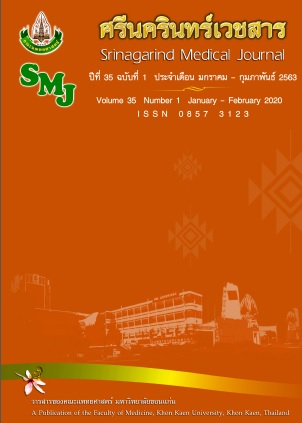ผลของการยืดกล้ามเนื้อทราพีเซียสร่วมกับการเจริญสติต่อการเปลี่ยนแปลงความตึง ตัวและคลื่นไฟฟ้ากล้ามเนื้อ
คำสำคัญ:
สมาธิ; ความผ่อนคลาย; การส่งเสริมสุขภาพตนเอง; ความตึงตัวบทคัดย่อ
หลักการและวัตถุประสงค์: การศึกษาที่ผ่านมาพบการเปลี่ยนแปลงความตึงตัวและคลื่นไฟฟ้ากล้ามเนื้อจากการยืดกล้ามเนื้อส่งผลลดอาการปวดคอ บ่า ไหล่ได้ และปัจจุบันมีการนำการเจริญสติที่เรียกว่าการทำอานาปานสติมาใช้ร่วมกับการบำบัดรักษากลุ่มอาการปวดต่างๆ แต่ยังไม่มีการศึกษาว่าหากนำทั้งสองวิธีมาใช้ร่วมกันจะเกิดผลอย่างไร ดังนั้นการศึกษานี้จึงต้องการศึกษาผลของการยืดกล้ามเนื้อร่วมกับการทำอานาปานสติต่อการเปลี่ยนแปลงความตึงตัวและคลื่นไฟฟ้ากล้ามเนื้อ
วิธีการศึกษา: ศึกษาในอาสาสมัครเพศหญิงสุขภาพดี อายุ 20-25 ปี จำนวน 26 ราย สุ่มเป็นกลุ่มศึกษาและกลุ่มควบคุม กลุ่มละ 13 ราย กลุ่มศึกษาได้รับการยืดกล้ามเนื้อ upper trapezius ร่วมกับการทำอานาปานสติ ส่วนกลุ่มควบคุมทำอานาปานสติเท่านั้น วัดผลก่อนและหลัง โดยใช้แบบวัดความตึงตัวกล้ามเนื้อ สัญญาณไฟฟ้ากล้ามเนื้อชนิดพื้นผิว และบันทึกการสัมภาษณ์ และการสังเกต ขณะทำการศึกษา
ผลการศึกษา: พบว่าทั้งสองกลุ่มมีความตึงตัวกล้ามเนื้อลดลงและผ่อนคลายอย่างต่อเนื่อง ทั้งนี้สัดส่วนรากที่สองของค่าเฉลี่ยของ sEMG ในกลุ่มศึกษามีแนวโน้มลดลงเมื่อเปรียบเทียบกับกลุ่มควบคุม ซึ่งการยืดกล้ามเนื้อ upper trapezius ร่วมกับการเจริญสติช่วยลดความตึงตัวกล้ามเนื้อและช่วยให้กล้ามเนื้อผ่อนคลายยิ่งขึ้น
สรุป: การใช้สมาธิและมีสติในการรับรู้ขณะปฏิบัติ นำไปสู่การพัฒนารูปแบบการยืดกล้ามเนื้อคอที่ให้ผลดีขึ้น
References
2. Losatiankij P. Buddhist psychotherapy: the aspect of mindfulness psychotherapy. J Ment Health Thai 2008; 16: 119-29.
3. Hofmann SG, Sawyer AT, Witt AA, Oh D. The effect of mindfulness-based therapy on anxiety and depression: A meta-analytic review. J Consult Clin Psychol 2010; 78: 169-83. doi:10.1037/a0018555.
4. Kabat-Zinn J, Massion AO, Krisletter J, Peterson LG, Fletcher KE, Pbert L et al. Effectiveness of a meditation- based stress reduction program in the treatment of anxiety disorder. Am J Psychiatry 1992; 149: 936-43.
5. Juengsiragulwit D, Thongthammarat Y, Praneetpolgrung P, Choompudsa P, Tantipiwattanasakul P. The efficacy of group mindfulness-based cognitive therapy in prevention of youth depression: a pilot study. J Ment Health Thai 2015; 23: 143-53.
6. Lauche R, Cramer H, Dobos G, Langhorst J, Schmidt S. A systematic review and meta-analysis of mindfulness-based stress reduction for the fibromyalgia syndrome. J Psychosom Res 2013; 75: 500-10.
7. Kabat-Zinn J. An outpatient program in behavioral medicine for chronic pain patients based on the practice of mindfulness meditation: theoretical considerations and preliminary results. Gen Hosp Psychiatry 1982; 4: 33-47. doi: 0.1016/0163-8343(82)90026-3. [PubMed: 7042457]
8. Kabat-Zinn J, Mindfulness-based intervention in context: past, present, and future. Clin Psychol: Science and Practice 2003; 10: 144-56.
9. Kaplan HI, Sadock BJ. Comprehensive text book of psychiatry. 7th ed. Verginia: Lipincott Williams and Wikins; 2000.
10. Segal ZV, William JMG, Teasdale JD. Mindfulness-based cognitive therapy for depression: A new approach to prevent relapse. New York: The Guilford Press; 2002.
11. Wongwilairat K, Buranruk O, Eungpinichpong W, Puntumathakul R, Triamchisri SK. Muscle stretching with deep and slow breathing patterns: a study for therapeutic development. J Complement Integr Med, 2018; 1-9. Available from: doi: https://doi.org/10.1515/jcim-2017-0167
12. Mourya M, Mahajan AS, Singh NP, Jain AK. Effect of slow- and fast-breathing exercises on autonomic functions in patients with essential hypertension. J Altern Complement Med 2009; 15: 711-17.
13. Coherence and the new science of breath. The science of coherent breathing-complete document; 2006. Retrieved from http://www.coherence.com/science_full_html_production.htm. [8 May 2016]
14. Buranruk O, Steven La Grow, Ladawan S, Makarawate P, Suwanich T, Leelayuwat N. Thai Yoga as an appropriate alternative physical activity for older adults. J Complement Integrat Med 2010; 7: 1-14. Available from: http://www.bepress.com/jcim/vol7/iss1/6 doi:10.2202/1553-3840.1290
15. Buranruk O, Eungpinitpong W. Effects of Ruesidadton, Chikung, and combination exercises on stress and quality of life in sedentary women. Journal of Medical technology and Physical therapy 2012; 25: 280-8.
16. Pal GK, Velkumary S, Madanmohan. Effect of short-term practice of breathing exercise on autonomic functions in normal human volunteers. Indian J Med Res 2004; 120: 115-21.
17. Widanarko B, Legg S, Stevenson M, Devereux J, Eng A, Mannetje A, et al. Prevalence of musculoskeletal symptoms in relation to gender, age, and occupational / industrial group. Int J Ind Ergonom 2011; 41: 561-72.
18. Melzack R. Pain and stress: a new perspective. In: Gatchel RJ, Turk DC. editor. Psychosocial factors in pain. New York: Guilford Press; 1999: 89-106.
19. World Health Organization (WHO). Obesity: preventing and managing the global epidemic. Report of a WHO consultation on obesity. Geneva: World Health Organization; 1998.
20. Paksaichol A, Janwantanakul P, Lawsirirat C. Development of a neck pain risk score for predicting nonspecific neck pain with disability in office workers: a 1-year prospective cohort study. J Manip Physiol Ther 2014; 37: 468-75.
21. Buranruk O, Eungpinichpong W, Konharn K, Ponwapi N, Chintakian P. A Survey of Musculoskeletal Disorder at Neck and Upper Extremities and Ergonomics Management in Computer Users. JMTPT 2018; 30: 29-38.
22. Plowman SA, Smith DL. Exercise physiology for health, fitness, and performance. 4th ed. Philadelphia: Lippincott Williams & Wilkins; 2014.
23. Søgaard K, Olsen HB, Blangsted AK, Sjøgaard G. Single motor unit firing behavior in the right trapezius muscle during rapid movement of right or left index finger. Front Hum Neurosci 2014; 8: 881.
24. Picavet HSJ, Schouten J. Musculoskeletal pain in the Netherlands: prevalences, consequences and risk groups, the DMC3-study. Pain 2003; 102: 167-78.
25. Sjøgaard G, Søgaard K, Hermens H, Sandsjo L, Läubli T, Thorn S, et al. Neuromuscular assessment in elderly workers with and without work related neck/shoulder trouble. The NEW-study design and physiological findings. Eur J Appl Physiol 2006; 96: 110-21. doi: 10.1007/s00421-005- 0042-3
26. Siegel DJ. The mindful brain. New York: W.W. Norton; 2007.
27. Chrousos GP, Goal PW. The concept of stress and stress system disorders. J Am Med Assoc 1992; 267: 1244-52.
28. Knudson D. The biomechanics of stretching. J Exerc Sci Phys 2006; 2: 3-12.
29. Losatiankij P, Teangtum S, Punchote K. The effect of mindfulness on stress, happiness and its usage in daily living. J Ment Health Thai 2006; 14: 199-206.



